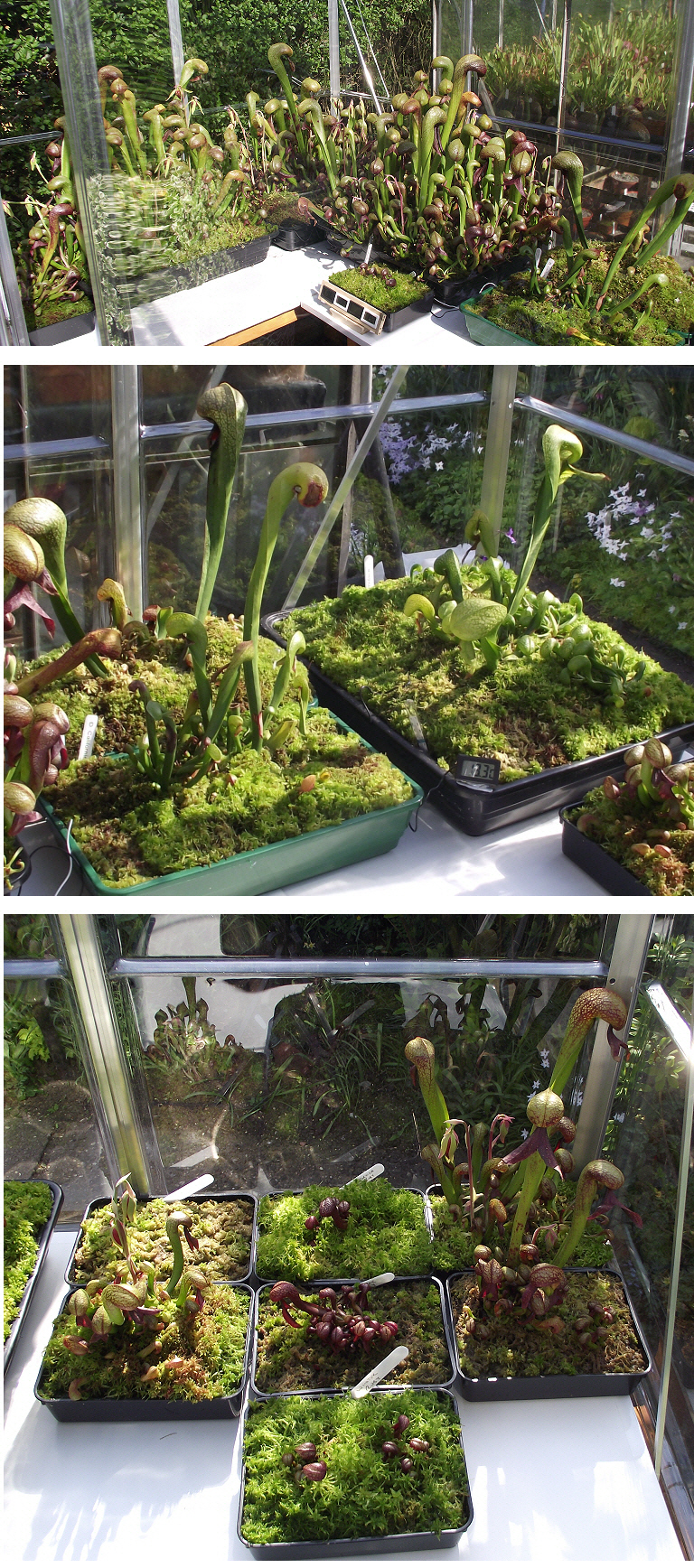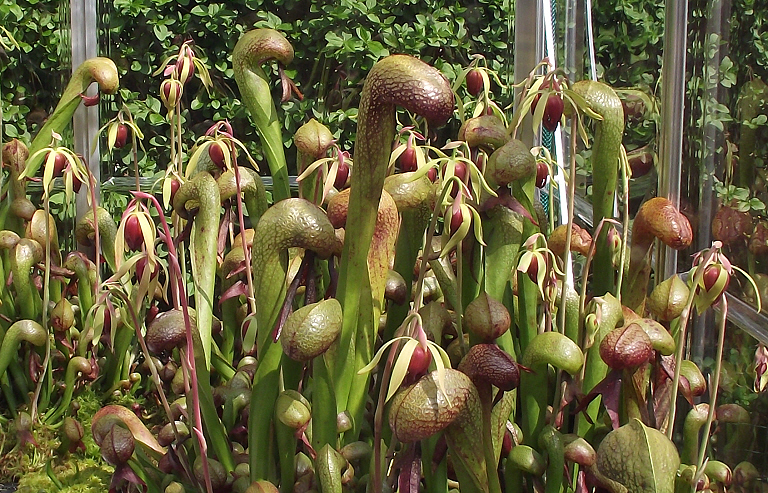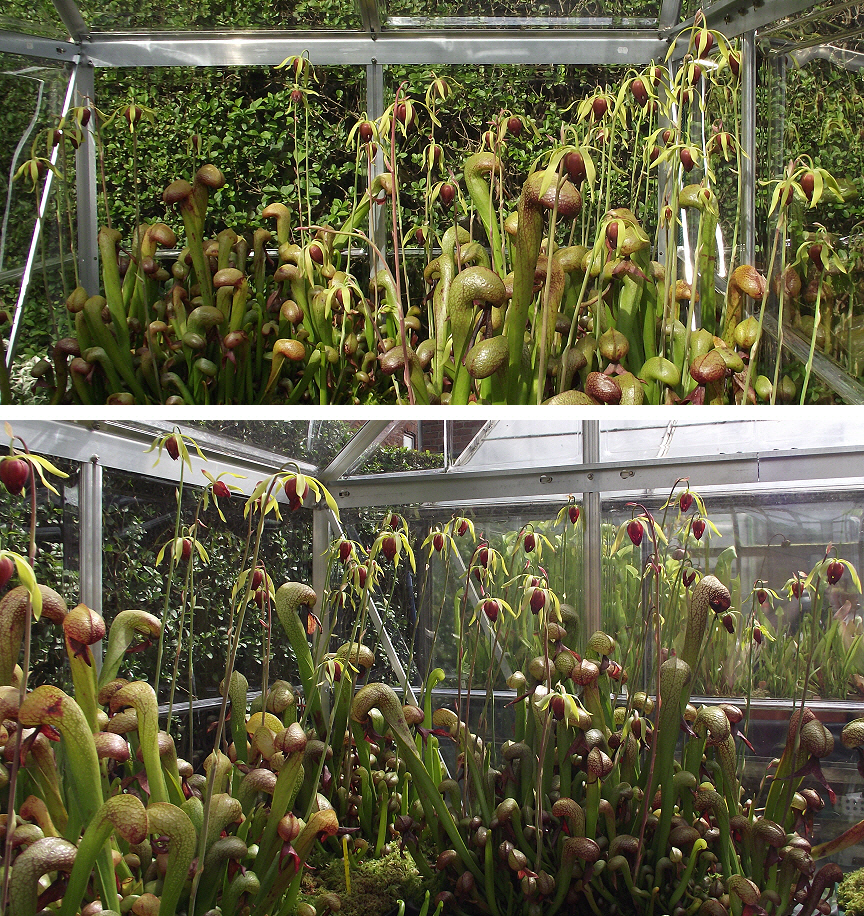fredg
Full Member
Posts: 367
|
Post by fredg on Apr 18, 2014 19:06:29 GMT
For some time now I have been struggling for room in my greenhouses so I took stock of the space I could make available and decided to purchase a small 6ft x 4ft ( 1.8m x 1.2m) polycarbonate greenhouse. This is intended to house my Darlingtonia and the odd bryophyte and /or orchid. One tree had to be felled and my reacquaintance with laying paving slabs and brickwork was required. The result is quite good, the structure being reassuringly solid. Ventilation is via the standard roof vent plus I replaced the bottom polycarbonate sheet in the door with wire mesh ( half the door). For a small greenhouse the staged growing area is quite good. I made staging to cover 20sq ft giving myself an adequate 2ft x 2ft area to stand in. I can stand on both feet at the same time at last. Here's how the plants look at present.   I'm looking forward to flowering, some are visible in the photos and many more are to follow. |
|
|
|
Post by sykosarah on Apr 19, 2014 3:12:49 GMT
Your cobra lilies are so awesome! I wish I lived in an area were growing them was reasonable, they are so great ;(
|
|
stevebooth
Full Member
Happy to be here
Posts: 140
|
Post by stevebooth on Apr 20, 2014 8:40:34 GMT
Looks very good Fred, looking forward to seeing the results. Are you sure you didn't overdo the personnel space  Cheers Steve |
|
fredg
Full Member
Posts: 367
|
Post by fredg on Apr 29, 2014 18:13:13 GMT
Oh the personal space is perfect Steve. The floor under the staging is now covered in trays of Sphagnum and Bryophytes. Flowering is progressing nicely.  |
|
fredg
Full Member
Posts: 367
|
Post by fredg on May 15, 2014 18:46:13 GMT
And a further update  |
|
|
|
Post by dirtyrabbits on May 30, 2014 16:01:07 GMT
Handsome plants! I live in Northern California and have the intent to grow californicas. And not in a wine bottle, I assure you...
|
|
fredg
Full Member
Posts: 367
|
Post by fredg on May 30, 2014 16:59:38 GMT
And not in a wine bottle, I assure you...  Good luck with that, you can see how I grow them in the UK. There's no guarantee that that method would be as successful for you but it must be worth a try. I think you may wish to consider this piece from Jeff Dallas I've really been exploring the pathogen issue recently. I've been working with OSU extension Master Gardeners, and there's a strong possibility that Darlingtonia is subject to Phytopthora or similar fungus infections. I've taken specimens of our plants that have shown the typical root rot, treated them by dipping them in Tebuconazole fungicide (Bayer Disease Control), and currently, to the plant, they have survived after the fungicide treatment. Since Phytopthora is water-borne it would make sense, and the their native Serpentine habitats may help inhibit it. Cultural conditions (cool root-run, water flow, aeration, planting in live sphagnum) probably all contribute to keeping whatever this fungus is at bay. I'd love to hear if anyone has more empirical evidence on this issue. Currently I recommend to customers that they not let Darlingtonia come in contact with the ground such as putting pots on the ground with regular soil or setting them out on a lawn. Jeff |
|
|
|
Post by dirtyrabbits on May 30, 2014 17:36:46 GMT
So plants rooted in live moss with a moving water source should give me a fighting chance, right?
|
|
fredg
Full Member
Posts: 367
|
Post by fredg on May 30, 2014 18:47:31 GMT
That's an affirmative. I don't use moving water and have no problems but I'm not over there on the west coast USA.
|
|
|
|
Post by dirtyrabbits on May 30, 2014 19:38:13 GMT
Excellent. Thanks for the input. I'm figuring that slowly moving water can't be a bad thing to implement. Also, it'll give me an excuse to tinker around building something..
|
|
|
|
Post by dirtyrabbits on Jun 5, 2014 18:47:16 GMT
Hey, Fred... I like to pick your brain for a second if you don't mind. I'm looking at my first darlingtonia and can't help but notice how similar it is to a sarracenia structurally. Hopefully, you "believe" in evolution and can cast some light on my novice question. It seems to me that, at some point, geography must have separated californicas from the rest of the sarracenia family, and their unique speciation was the result. The distinctive mustache of darlingtonia seems to be nothing more than a slight tweak of a pitcher lid that was afforded by the result of an inverted, bell shaped, opening to the trap. What are your thoughts? P.s. I realize I may be treading on thin ice in asking you amateur questions, but I admire your harsh responses to other posts. To me, it indicates you are very knowledgeable and passionate about plant related matters... Attachments:
|
|
fredg
Full Member
Posts: 367
|
Post by fredg on Jun 6, 2014 16:07:35 GMT
Questions on the evolution of the Sarraceniaceae as far as I am concerned are better addressed to the botanical experts.  I'm just a simple grower. Me harsh? Wash your mouth out with soap young man. |
|
|
|
Post by dirtyrabbits on Jun 7, 2014 7:45:13 GMT
You have what appears to be scores of a species of plant that, by many accounts, is rather difficult to cultivate. To me, this is an indication that you aren't just some lucky ding-a-ling with a greenhouse. I'm sure you must have a hypothesis....
|
|







